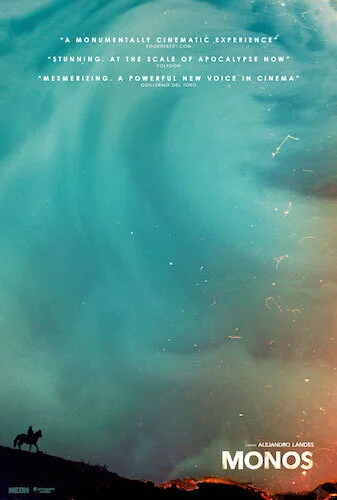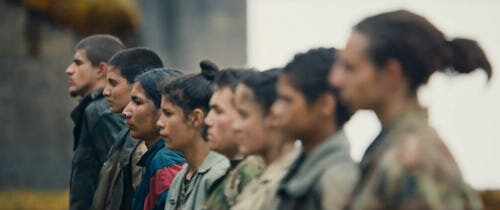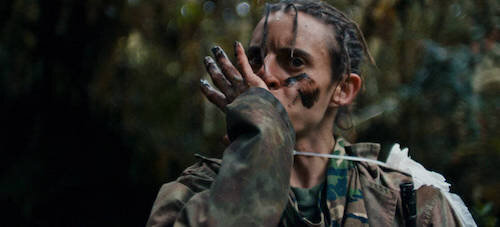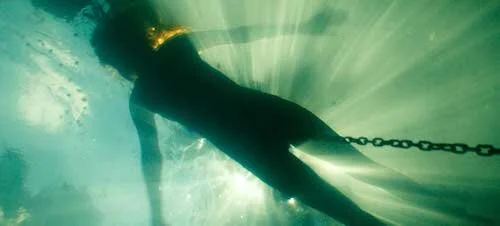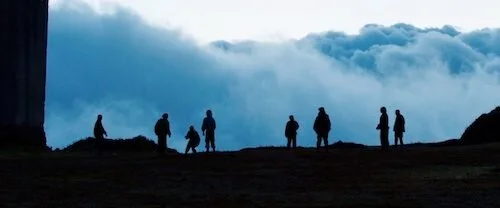Monos
Every once in a while, a film that’s as poignant as it is dangerous comes out. While you may keel over in disgust, you look back to not miss a thing. You know this is a temporary cinematic story, and that you will have lots of time afterwards to reflect. It’s hard to keep looking, but you must. Monos is such a film of this nature. Inspired by the William Golding novel Lord of the Flies, Monos deals with misshapen youths that turn in on each other. Instead of a pig’s head, we have a cow. Instead of a crash landing, we have a life devoted to an unknown superior within the criminal underworld. As much as we can relate Monos to Flies, I kept thinking of two other works: Aguirre, with its mental meltdowns in the middle of an unforgiving forest, and Salò, with its depictions of innocence being shattered in the most corrupt and disturbing of ways.
It might be unfair to compare Alejandro Landes with Wener Herzog or Pier Paolo Pasolini, because Landes was definitely operating under his own vision here. It does help to lean on other sources when it comes to such raw art, because it allows us to wrap our brains around what we’ve witnessed. From shot one, Monos is a stranglehold, where you know right away that all is not well. You’re viewing everything from hostile eyes. From that second onwards, Monos never ever takes a break. Even in its lighter moments, you’re sitting alongside brainwashed teenagers who don’t have the free will they may feel they have. Even times of intimacy are conflicting. Nothing feels intended. Everything is preprogrammed into the minds of these kids. Do they actually love who they love, or are these the only instances of compassion they feel? Even then, nothing feels okay.
The eight teenagers, stricken by orders of command and criminal overtakings.
Here’s the skinny. These eight teens are instructed to keep tabs on both a kidnapped citizen (a multilingual engineer), and a gifted cow meant to provide milk. As you can imagine, things go awry very quickly. What’s more important to focus on right now, is how the engineer (referred to as “Doctora”: a similar nick name to the ones all of the commandos have) is reminiscent of the cow (as if Robert Bresson wrote the screenplay). As the cow gives milk, Doctora can send out messages. As the cow is chained up, so is Doctora. The cow is forced to do manual labour. So does Doctora, who is held against her will to take part in vicious activities she doesn’t like.
Unfortunately, the slaughter of cows has been a frequent source of symbolism in cinematic history. In Sergei Eisenstein’s Strike, we see shots of a cow being murdered to represent the mass genocide of the working class. In Apocalypse Now, a cow is sacrificially slain during another crucial part: the significance of the deed being pulled off. In Monos, we have a harbinger of things to come: decisions used as a means of sustaining life, only to cause life to wither and end during these attempts. It’s hard to justify these actions, even if the meat is used as nourishment after a shoot. We luckily don’t see anything on screen for Monos, but I can’t say for sure how much is the achievement of a special effects team, and how much is the real thing. Either way, Monos is meant to provoke, and you learn pretty quickly that it does.
One of the commandos in pursuit.
Landes’ film was geared to have you thinking throughout. That is clear. What helps achieve this intention are the marriage of two blisteringly powerful forces: Mica Levi and Jasper Wolf. Firstly, I’m going on record. More people should be hiring Mica Levi to do their scores (I’m hoping her scant filmography is due to her own busy schedule). After Under the Skin and Jackie, we now have the score to Monos: an equally breathtaking compilation of moods, fears, and gasps. At this point, with all things considered, Mica Levi is the strongest cinematic score composer to emerge from this decade (even with only three features under her belt). I dare anyone to try and find another song writer with songs this original, unsettling, emotional, and complex. This is beyond another home run for Levi. Much of the film’s tension comes from her ability to craft feelings that are impossible to pinpoint. Three minutes in, and you get “Guerreros”: a pulsating blend of synth strings and organic woodwinds. You know right there and then that Levi has a series of sounds ready to puncture your soul. It’s an exciting prelude for sure, especially since the songs only get better.
As for Wolf’s cinematography, I can only state that his photography is the precise visual representation of Levi’s score. The natural jungle shots are so vibrantly colourful, as if you are unsure whether or not this is the result of post editing work or if this is the real thing. Nothing literally is synthetic narratively in Monos, but you’re dealing with the desecration of the anatomy and the foundations of civilizations. Wolf is able to frame all of the carnage and make it beautiful; he similarly makes even the prettiest shots of nature feel uneasy. Monos is all about never feeling safe, even in the lushest gardens of the wild.
Much of the dark subject matter is found within exhilarating shots like this.
To go back to the Flies inspiration, Monos does deal with similar themes of anarchistic corruption. Flies intended to teach young schoolchildren that the lack of order will lead to more disastrous results. Monos has a boot on the neck of these commando teens, implying that all of this is because of an order. As a vague and open political statement, Monos reflects on some current topics (misled younger generations, hostages of war, criminal warlords) with just enough rope to have you guessing. The mystery here is what makes you the most sick. Why are these kids here? Where did they come from? Were they told to take part in this mission? Was it even their choice? We never fully find out (not with the amount of answers you may be hoping for, anyway), but that is far from a flaw. Sometimes, knowing less is more of a statement than knowing every detail.
Every shot is a wince you will be fighting off. You feel held captive there, like the Doctora character. You barely find out much as you go along. All you see is the literal: death, love, torture, and coercion. Monos has been deemed controversial, and it’s very easy to see why (excluding even the highly graphic cow sequences). The film is very blunt about what it’s showcasing. It says very little, but offers so damn much. Wolf is there to capture every second. Levi is there to transcribe the waves of heightened anxiety into sounds.
I hope the Academy accepts Columbia’s offer of Monos as their selection for the Best International Feature Film, but it might be just a little too much. Well, if the Academy was fine with the bonkers Dogtooth and the punishing Incendies, maybe they will be fine with the overwhelming Monos: similarly a difficult conversation to have, impossible images to swallow, and all of the sensory ambiguities that cinema can offer. You may not quite know what to think after witnessing this fight for life, but you may not necessarily have to have a coherent thought right away. Some films — even the challenging ones — are meant to be sans-label. Monos is a flurry of experiences all smushed together. You don’t quite know what you’re feeling, but you need to finish this once and for all. Entering back into the real world may be a test of its own, to be honest.
Andreas Babiolakis has a Masters degree in Film and Photography Preservation and Collections management from Ryerson University, as well as a Bachelors degree in Cinema Studies from York University. His favourite times of year are the Criterion Collection flash sales and the annual Toronto International Film Festival.

